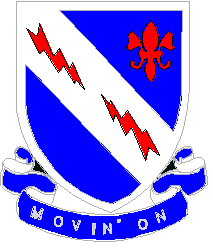
1/279th Infantry Regiment

|
The 279th Infantry Regiment was granted federal recognition
on 5 September 1946 to replace the deactivating 157th Infantry
Regiment. Geography exerted a significant influence on the
stationing of 279th Infantry units. To accommodate the new
regiment, the state was divided into three geographical areas:
Northeast Oklahoma, including Stillwater, Tulsa, Muskogee,
and Okmulgee was assigned to the 279th. Accordingly, the
Regiment included a number of veterans from the 179th and
180th Infantry Regiments, and veterans from special units
that had formerly been stationed in the area. These veterans
brought with them their pride and experience and dedicated
their efforts to making sure the 279th measured up to the
standards of the Thunderbird. COL Thad E. Hummel, an employee of the Stanolind Oil Company in Tulsa, was assigned to be the first commander of the 279th. HHC of the 279th was established in Tulsa along with the Service Company, and Medical Company. The Heavy Tank Company was established in Nowata and the Heavy Mortar Company was later established in Muskogee. In the spring of 1948, the Regiment surpassed its sister Regimentís with strength of 104 officers and 1,634 enlisted. This was due to an intense recruiting campaign that began with activation in 1946 and lasted through 1949. Headquarters 1st Battalion 279th Infantry Regiment was established in Stillwater. LTC Sam Meyers was assigned as the Battalion Commander. MAJ Jasper N Baker was assigned as the Executive Officer. 2nd Battalion 279th Infantry Regiment was established in Okmulgee with MAJ John L. Hillman commanding. MAJ Hillman commanded the battalion throughout the Korean Conflict and upon return until his retirement. 3rd Battalion 279th Infantry Regiment was established in Muskogee with MAJ Don E. Burnett commanding. CPT Haskell G. Clark was assigned as the Executive Officer. A number of changes were made in the 279th by the end of 1949. Plans were made to begin Annual Training at FT Hood, TX rather tan FT Sill, OK. LTC Herbert G. Sitler was appointed to succeed COL Hummel as the Regimental Commander. The Regimental Headquarters was moved from Tulsa to Okmulgee. The Heavy Mortar Company and Company I was moved from Muskogee and Nowata to Beggs. The Service Company was moved from Tulsa to Henryetta. Company E was moved from Begs to Broken Arrow. Company A was moved from Pawhuska to Ponca City. LTC John Hillman was appointed as Regimental Executive Officer. The 2nd Battalion was moved to Tulsa. The 279th served with the 45th Division throughout the Korean Conflict. With the Division, the 279th was federalized on 1 September 1950. Initially, the Regiment moved to Camp Polk. LA. While at Camp Polk, the Regiment under went and intense training period. Basic raining was conducted for recruits that had been brought to Camp Polk with the Division. Junior Officers were assigned to training committees to prepare and operate fire ranges and individual combat courses. The primary burden of leadership and training fell on the Non-Commissioned Officers (NCOs). Fortunately, the 279th was blessed with an outstanding cadre of battle tested NCOs. The basic training schedule was completed in February 1951 and small unit tactical training began. However, in early March 1951, the Division was alerted for movement to Japan. With New Orleans as the Point of Embarkation, the Division moved to the island of Hokkaido, Japan on 31 March. During the trip, the officers had daily training classes in the large wardroom. Upon arrival in Hokkaido, the Division continued training and assumed responsibility for the military security of the island. To the veteran Thunderbirds, Camp Crawford was unbelievable. Never in their history had they been stationed at such a nice army post. There were excellent facilities, steam heated barracks, a large PX, a beautiful chapel, and clubs for all ranks. While in Japan, the Regiment was joined by the 160th Field Artillery Battalion, Company C 120 Combat Engineers, Battery C 145 Anti-Aircraft Battalion, and 3rd Platoon, 45th Military Police Company. These units comprised the 279th Regimental Combat Team. Throughout the summer, the regiment trained 10-days with 1 day off. The days began shortly after midnight and ended long after dark. The 279th sailed from Otaru, Japan and landed at Inchon, Korea on the evening of 28 December 1951. Initially, the 279th was assigned to defend a section of Line Jamestown near the 38th Parallel reaching westward from the Chorwon Valley. Throughout the conflict, the Regiment fought with distinction. By July 1952, most of the original soldiers in the Regiment had arrived home. Since 1952, the Regiment has undergone numerous reorganizations. With the disbanding of the Division in 1968, the 279th went from being a Regiment of 3 battalions to a single infantry battalion. Back to top of page Back to Main Page |